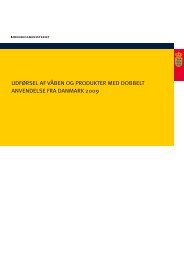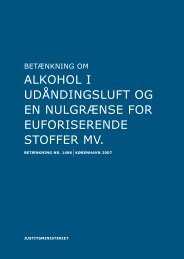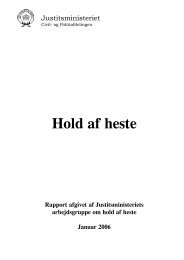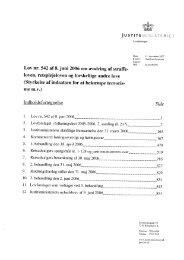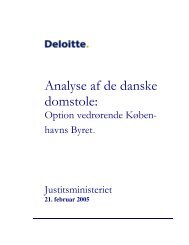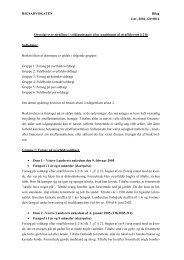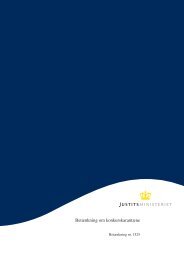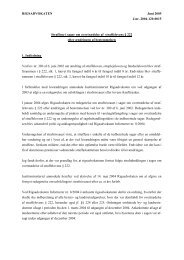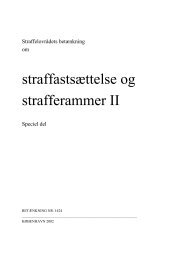- Page 1 and 2: FARUM-KOMMISSIONEN · Bind 11 Rejse
- Page 3 and 4: BIND 11 Kapitel 15 Pensionistrejser
- Page 5 and 6: 17.5.1. Kommunens behandling af til
- Page 7 and 8: 17.8.6.4.2. Farum & Erhverv 291 17.
- Page 9 and 10: 15. Pensionistrejser 15.1. Den retl
- Page 11 and 12: … 135. Kommunen kan … træffe b
- Page 13 and 14: måned 42.000 kr. eksklusiv moms. 1
- Page 15 and 16: 2001. 1 På rejserne deltog mindst
- Page 17 and 18: e) Udgifter: Bortset fra velkomst-
- Page 19 and 20: Helsingør, den 13. marts 2000 Komm
- Page 21 and 22: undersøgelse, som var utrolig posi
- Page 23 and 24: det, eller oplysninger om mellemreg
- Page 25 and 26: Foreholdt Farum Kommunes budget 200
- Page 27 and 28: lægsrejse, og der blev sat en pris
- Page 29 and 30: Bjarne Jensen, BJ Consult, har fork
- Page 31 and 32: Tyrkiet, og at den aftale, de havde
- Page 33 and 34: Kapitel 16 16. Bertelsmann og Citie
- Page 35 and 36: - På mandag tager Brixtofte til Ty
- Page 37 and 38: I Weekendavisens artikel den 15. ok
- Page 39 and 40: I en artikel i Frederiksborg Amts a
- Page 41 and 42: vet til os for at sige, at vi var i
- Page 43 and 44: at understøtte de folkevalgte i, a
- Page 45 and 46: - Blev der gennemført et sådant s
- Page 47 and 48: tisk av Bertelsmann. Hvordan, vet d
- Page 49 and 50: ∗ I den samme periode er grundsky
- Page 51: 4. …” morrow”, signed by Prof
- Page 55 and 56: - 53 -
- Page 57 and 58: 16.4. Cities of Tomorrow Som beskre
- Page 59 and 60: Even though this has been a difficu
- Page 61 and 62: Efter anmodning fra Farum Kommune u
- Page 63 and 64: Kapitel 17 17. Rejser og repræsent
- Page 65 and 66: Amts Avis ”Brixtofte skærer i re
- Page 67 and 68: Også disse rejser og besøg gav an
- Page 69 and 70: 17.3. Den retlige ramme Under emnet
- Page 71 and 72: Tilsidesættes pligten til at handl
- Page 73 and 74: 17.4.1.1. Kommunernes Revision indd
- Page 75 and 76: Vi gav i øvrigt bgm. en kopi af de
- Page 77 and 78: Der vedlægges til orientering kopi
- Page 79 and 80: Med henblik på, at der ikke skal f
- Page 81 and 82: 1990. 1 Den 12. marts 1990 indbød
- Page 83 and 84: vedlagt en redegørelse for opposit
- Page 85 and 86: ning i Farum, Gerd Jochimsen, og de
- Page 87 and 88: eller ”forklædet”. I nogle til
- Page 89 and 90: 1997 For året 1997 omfatter unders
- Page 91 and 92: at de lærte ikke at gøre sig sår
- Page 93 and 94: gen og tilsynsrådet. Adspurgt af a
- Page 95 and 96: Vidnet flyttede til Århus i 1991,
- Page 97 and 98: For så vidt angår årene 1998 og
- Page 99 and 100: Den uvildige undersøger skal dog k
- Page 101 and 102: nedenfor. Et mindretal på 3 fra CD
- Page 103 and 104:
tagelse i rejsen eller aktiviteten.
- Page 105 and 106:
Sag Resultat Gran Canaria sep. 2000
- Page 107 and 108:
I det efterfølgende byrådsmøde,
- Page 109 and 110:
om, i hvilket omfang nogen har påd
- Page 111 and 112:
Særligt om repræsentationsudgifte
- Page 113 and 114:
Farum Kommune Leif Frimand Jensen i
- Page 115 and 116:
Der henvises især til Tilsynsråde
- Page 117 and 118:
10. Afslutningsvis skal Tilsynsråd
- Page 119 and 120:
Det skal endvidere bemærkes, at Fa
- Page 121 and 122:
Vidnet Mona Egebjerg har forklaret:
- Page 123 and 124:
Gennemførelse af tilbagebetalingsk
- Page 125 and 126:
nomiudvalg og Byråd. Dette ansvar
- Page 127 and 128:
gange, eller om der bevidst er sket
- Page 129 and 130:
Borgmesteren Byrådssekretariatet I
- Page 131 and 132:
• kasse- og regnskabsregulativets
- Page 133 and 134:
og valg af ugedage var afhængig af
- Page 135 and 136:
dokumentation for, at udgifterne d
- Page 137 and 138:
”Undersøgelsens formål er følg
- Page 139 and 140:
• endelig afklaring af udbetaling
- Page 141 and 142:
Øvrige bilag var bilag 4 ”A-cont
- Page 143 and 144:
17.6.6. Forklaringer Foruden kommis
- Page 145 and 146:
Vidnet Flemming Birger Oppfeldt (V)
- Page 147 and 148:
17.6.6.2. Embedsmænd Vidnet Birgit
- Page 149 and 150:
ne gøre noget ved det. Hun havde g
- Page 151 and 152:
… Det var almindeligt, når regni
- Page 153 and 154:
encen, det år om integrationspolit
- Page 155 and 156:
Vidnet John Olsen har forklaret: 1
- Page 157 and 158:
holdt byfest. Der blev brugt rigtig
- Page 159 and 160:
I det omfang Farum Kommune ikke eft
- Page 161 and 162:
Jeg må således på det bestemtest
- Page 163 and 164:
søgt at kategorisere de enkelte bi
- Page 165 and 166:
fe, vand, sandwich m.m. Som den eft
- Page 167 and 168:
På samme vis er det vanskeligt at
- Page 169 and 170:
Der ligger med andre ord ikke en By
- Page 171 and 172:
ningen af ”dagarrangementer” p
- Page 173 and 174:
lativt få restaurationsudgifter i
- Page 175 and 176:
afsluttende revisionsberetninger fo
- Page 177 and 178:
Herefter fulgte en nærmere beskriv
- Page 179 and 180:
Kommunaldirektør Karsten Ole Knuds
- Page 181 and 182:
ådighed fra Farum Kommunes side, s
- Page 183 and 184:
”indkøbt primært til gaveformå
- Page 185 and 186:
”Det er utvivlsomt en relevant ko
- Page 187 and 188:
17.7.3.4. Tilskud og gaver mv. Unde
- Page 189 and 190:
Formål 2000 2001 Beløb Gaveartikl
- Page 191 and 192:
Delrapporten for 1999 omtaler følg
- Page 193 and 194:
Af indføjelsen i Peter Brixtoftes
- Page 195 and 196:
Det har derfor formodningen mod sig
- Page 197 and 198:
dige indledt en sag om tilbagesøgn
- Page 199 and 200:
I den uvildige undersøgelse er der
- Page 201 and 202:
Steen Gensmann. Udvalgsformandsmød
- Page 203 and 204:
de fremover ville bruge flere lever
- Page 205 and 206:
Vidnet Leif Frimand Jensen har fork
- Page 207 and 208:
17.8. Rejser 1998-2002 17.8.1. Gene
- Page 209 and 210:
Til sammenligning var der i Farum K
- Page 211 and 212:
… Told & Skat har yderligere kons
- Page 213 and 214:
Quebec, Canada ”Farum Kommune del
- Page 215 and 216:
17.8.2.2. 2000-2001 Det hedder i de
- Page 217 and 218:
”I have discussed the outcome of
- Page 219 and 220:
Det hedder bl.a.: 1 ”18.5 Decembe
- Page 221 and 222:
get repræsentative program, giver
- Page 223 and 224:
18.11 April 2001 I dagene 13. - 15.
- Page 225 and 226:
18.14 Juni 2001 … der er udbetalt
- Page 227 and 228:
17.8.4.1. 1999 Delrapporten for 199
- Page 229 and 230:
”Henset til Farum Kommune og Krü
- Page 231 and 232:
17.8.5. Andre rejser Under disse re
- Page 233 and 234:
konti for en indbetaling på det n
- Page 235 and 236:
Farum Kommune har den 25. juni 1998
- Page 237 and 238:
Rejse til Australien 23. september
- Page 239 and 240:
det grundlag for at kritisere det k
- Page 241 and 242:
Den skete refusion for rejseomkostn
- Page 243 and 244:
Alle 3 faktorer er vigtige, men ude
- Page 245 and 246:
6. november 1999, men vi har fortsa
- Page 247 and 248:
Sagen blev behandlet på ØU d. 3.
- Page 249 and 250:
Farum Butikken ved Søren Hjorth fo
- Page 251 and 252:
Vi kan ikke vide, hvor mange der ko
- Page 253 and 254:
Sagen vedrørende Wien-rejsen blev
- Page 255 and 256:
Vi kender ikke formålet med rejsen
- Page 257 and 258:
Farum Kommunes venskabsbysamarbejde
- Page 259 and 260:
Det drejer sig om følgende rejser:
- Page 261 and 262:
Der blev senere udtaget stævning m
- Page 263 and 264:
Vi er ikke i besiddelse af oplysnin
- Page 265 and 266:
markant misforhold mellem dette beg
- Page 267 and 268:
Formålet med medlemskabet af foren
- Page 269 and 270:
Jørn Frederiksen har dog ved e-mai
- Page 271 and 272:
Hüseyin Tas afgav den 21. septembe
- Page 273 and 274:
Økonomiudvalget behandlede de to r
- Page 275 and 276:
”ikke diskuterede, hvad et intern
- Page 277 and 278:
Kommune…” Adspurgt af kommissio
- Page 279 and 280:
erindrer rejsen til Gran Canaria, h
- Page 281 and 282:
Bertelsmann Fonden. Ti kommuner hav
- Page 283 and 284:
Vidnet Søren Hjort har forklaret,
- Page 285 and 286:
På den første rejse til Litauen d
- Page 287 and 288:
Vidnet Mogens Hovgaard Nielsen (V)
- Page 289 and 290:
Bruxelles, 27. - 29. september 1996
- Page 291 and 292:
havde skrevet et brev til kommunen
- Page 293 and 294:
lavere pris for deres del af turen,
- Page 295 and 296:
17.8.6.4.3. Erhvervssamarbejde i ø
- Page 297 and 298:
te, der skulle have været af sted,
- Page 299 and 300:
Der var to rejser i november 1999 l
- Page 301 and 302:
17.9.1.1. Repræsentation • Julef
- Page 303 and 304:
Ved stævning af 26. oktober 2004 m
- Page 305 and 306:
På denne baggrund bad forvaltninge
- Page 307 and 308:
Økonomiudvalget besluttede, at de
- Page 309 and 310:
Forvaltningen anmoder advokat Lars
- Page 311 and 312:
Furesø Kommune havde inden beslutn
- Page 313 and 314:
17.10. Domme og praksis i lyset her
- Page 315 and 316:
Vedrørende anvisning af regninger
- Page 317 and 318:
Rom, Amalfi, La Manga og Lanzarote.
- Page 319 and 320:
aktiviteter af kulturel art i øvri
- Page 321 and 322:
pligtelse til at tilbagebetale bel
- Page 323 and 324:
hov for at afdække, om der var afh
- Page 325 and 326:
Disse underforhold er grupperet så
- Page 327 and 328:
vinen, at Brixtofte ikke har vidst
- Page 329 and 330:
tiltalte Brixtofte, jfr. særlig de
- Page 331 and 332:
kelte tilfælde skal udskilles og s
- Page 333 and 334:
”Hvor forhold 6 vedrører det for
- Page 335 and 336:
17.10.4. Indenrigs- og Sundhedsmini
- Page 337 and 338:
omhandlede arrangement. Ministeriet
- Page 339 and 340:
Den anden sag, statsforvaltningsdir
- Page 341 and 342:
Det er afgørende at skelne mellem
- Page 343 and 344:
2. Retningslinier vedrørende anvis
- Page 345 and 346:
udgettet, som naturligvis skal over
- Page 347 and 348:
2. For embedsmænds anvendelse af F
- Page 349 and 350:
”Det er ikke en stor historie, me
- Page 351 and 352:
Den 13. februar 2002 undertegnede H
- Page 353 and 354:
23.000 km, jf. den som bilag 3 i ko
- Page 355 and 356:
Dette skal tillige ses i sammenhæn
- Page 357 and 358:
han formentlig blev kørt af Mogens
- Page 359 and 360:
Spørgsmålet om kuvertpriser efter
- Page 361 and 362:
Byretten har i sine præmisser sær
- Page 363 and 364:
KR’s opfattelse, at bilagene ”i
- Page 365 and 366:
17.14.3. Særligt om borgmesterbil
- Page 367 and 368:
Efter folkeoplysningslovens § 16,
- Page 369 and 370:
For så vidt angår rabatter på el
- Page 371 and 372:
F. Andre mødetyper Ad. A. Medlemsm
- Page 373 and 374:
”Partiforeningen har aldrig fået
- Page 375 and 376:
”Som det fremgår, har SF-Farum m
- Page 377 and 378:
politikere med til mødet. Det var
- Page 379 and 380:
ådsgruppen. Det foregik udelukkend
- Page 381 and 382:
Vidnet Leif Frimand Jensen, ordfør
- Page 383 and 384:
Vidnet Lis Jakobsen, medlem af byr
- Page 385:
er nærmere behandlet i kapitel 17.





